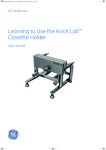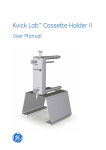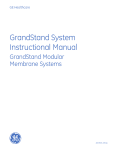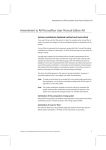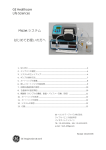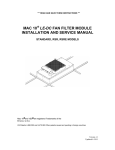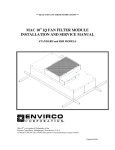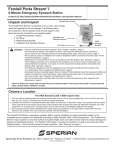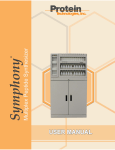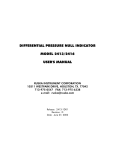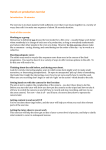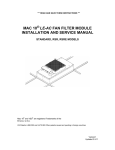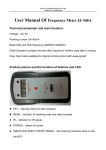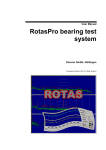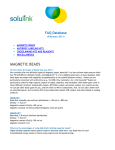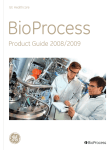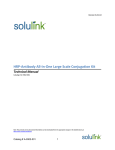Download Learning to Use the Kvick Flow Cassette Holder
Transcript
18117271AC.book Page 1 Tuesday, September 26, 2006 9:33 AM GE Healthcare Learning to Use the Kvick Flow Cassette Holder User Manual 18117271AC.book Page 2 Tuesday, September 26, 2006 9:33 AM 18117271AC.book Page 3 Tuesday, September 26, 2006 9:33 AM Important user information All users must read this entire manual to fully understand the safe use of Kvick Flow Cassette Holder. WARNING! The WARNING! sign highlights instructions that must be followed to avoid personal injury. It is important not to proceed until all stated conditions are met and clearly understood. CAUTION! The CAUTION! sign highlights instructions that must be followed to avoid damage to the product or other equipment. It is important not to proceed until all stated conditions are met and clearly understood. Note The Note sign is used to indicate information important for trouble-free and optimal use of the product. CE Certifying This product meets the requirements of applicable CE-directives. A copy of the corresponding Declaration of Conformity is available on request. The CE symbol and corresponding declaration of conformity, is valid for the instrument when it is: – used as a stand-alone unit, or – connected to other CE-marked GE Healthcare instruments, or – connected to other products recommended or described in this manual, and – used in the same state as it was delivered from GE Healthcare except for alterations described in this manual. Recycling This symbol indicates that the waste of electrical and electronic equipment must not be disposed as unsorted municipal waste and must be collected separately. Please contact an authorized representative of the manufacturer for information concerning the decommissioning of your equipment. 18117271AC.book Page 4 Tuesday, September 26, 2006 9:33 AM 4 Ettan Spot Handling Workstation Site Preparation Guide 18-1153-53 Edition AC 18117271AC.book Page 5 Tuesday, September 26, 2006 9:33 AM Contents Contents 1 Introduction 1.1 1.2 1.3 1.4 1.5 2 Cassette Holder 2.1 2.2 2.3 2.4 2.5 2.6 3 About this user guide ....................................................................................................................................................................7 Audience .............................................................................................................................................................................................7 Where to find more information ..............................................................................................................................................7 Safety ...................................................................................................................................................................................................9 Warnings, Cautions, and Expert Advice ............................................................................................................................ 10 Package Contents ....................................................................................................................................................................... 13 Learning about the holder ...................................................................................................................................................... 13 Features ........................................................................................................................................................................................... 14 Hydraulic pump ............................................................................................................................................................................ 15 Operating the hydraulic pump .............................................................................................................................................. 15 Learning about cassettes ........................................................................................................................................................ 16 Connecting the Holder to your System 3.1 Where to install the holder ...................................................................................................................................................... 17 3.2 How to install the holder .......................................................................................................................................................... 18 3.3 Making the connections ........................................................................................................................................................... 18 4 Installing Cassettes in the Holder 4.1 4.2 4.3 4.4 5 Preparing a Cassette for Use 5.1 5.2 5.3 5.4 5.5 5.6 6 Introduction .................................................................................................................................................................................... 37 Stage 1 – Starting the cross-flow process ....................................................................................................................... 39 Stage 2 – Operating the system in a steady state ...................................................................................................... 40 Stage 3 – Shutting the system down and recovering product .............................................................................. 40 Cleaning and Storing 7.1 7.2 7.3 7.4 8 Introduction .................................................................................................................................................................................... 23 Stage 1 – Rinse storage solution from the cassette ................................................................................................... 24 Stage 2 – Measuring water flux ............................................................................................................................................ 26 Stage 3 – Test the Integrity of the cassette .................................................................................................................... 30 Stage 4 – Sanitizing the cassette ......................................................................................................................................... 33 Stage 5 – Conditioning the system with buffer ............................................................................................................. 34 Using the Holder 6.1 6.2 6.3 6.4 7 Introduction .................................................................................................................................................................................... 19 Determining how many cassettes you can install ...................................................................................................... 19 Installing the cassettes in the Regular Kvick Flow Holder ........................................................................................ 19 Installing the cassettes in the Extended Kvick Flow Holder .................................................................................... 21 Introduction .................................................................................................................................................................................... 43 Stage 1 – Cleaning a cassette after use ........................................................................................................................... 43 Stage 2 – Measuring water flux ............................................................................................................................................ 44 Stage 3 – Storing the cassette and holder ...................................................................................................................... 44 Troubleshooting 8.1 Troubleshooting guide .............................................................................................................................................................. 45 Learning to Use the Kvick Lab Cassette Holder User Manual 18-1172-69 Edition AG 5 18117271AC.book Page 6 Tuesday, September 26, 2006 9:33 AM Contents 9 Maintenance 9.1 9.2 9.3 9.4 Inspection ........................................................................................................................................................................................ 47 Maintenance .................................................................................................................................................................................. 47 Storing the holder ........................................................................................................................................................................ 47 Recycling ......................................................................................................................................................................................... 47 10 Specifications 10.1 10.2 10.3 10.4 10.5 Size and dimensions ................................................................................................................................................................... 49 Size and dimensions (extended holder) ............................................................................................................................. 49 Materials of construction ......................................................................................................................................................... 49 Operating parameters .............................................................................................................................................................. 49 Hydraulic Pump ............................................................................................................................................................................ 50 11 Appendix 11.1 Chemical compatibility ............................................................................................................................................................. 51 11.2 Cassette sanitizing agents ...................................................................................................................................................... 51 12 Parts 12.1 Part Descriptions .......................................................................................................................................................................... 53 13 Index 6 Learning to Use the Kvick Lab Cassette Holder User Manual 18-1172-69 Edition AG 18117271AC.book Page 7 Tuesday, September 26, 2006 9:33 AM Introduction 1 1 Introduction 1.1 About this user guide This user guide describes how to use the GE Healthcare Kvick Flow™ cassette holder (regular and extended models). Topics include how to integrate and connect the holder to your cross-flow system, how to install cassettes, and how to use and clean the holder and cassettes. 1.2 Audience This user guide addresses the needs of scientists, process engineers, and technicians who operate laboratory and pilot cross-flow systems. The content and level of detail presented assumes the user possesses basic laboratory and technical skills and has the knowledge and documentation to safely and properly operate any user-supplied equipment to which the cassette holder is attached. If you need assistance with the instructions in this guide, contact your sales representative or GE Healthcare for more information. 1.3 Where to find more information You can consider this user guide as part of a set. When you purchase Kvick Flow cassettes or a Kvick Flow cross-flow system, you receive the other documents in the set (Fig 1). You can download technical documents and learn more about Kvick Flow cassette holders and cross-flow systems by visiting our website, www.gehealthcare.com. In the USA, you can contact our customer and technical support teams by calling 1-800-526-3593. Outside of the USA, you can contact your local GE Healthcare representative using the telephone numbers listed at the back of this user guide. You can also receive customer and technical support by emailing us at these addresses: • Technical Support: [email protected] • Customer Service: [email protected] • Europe Customer Service: [email protected] Learing to Use the Kvick Flow Cassette Holder User Manual 18-1172-71 Edition AC 7 18117271AC.book Page 8 Tuesday, September 26, 2006 9:33 AM 1 Introduction Kvick Flow Cross-Flow System: Instructions for Use – Describes how to install, use, and maintain the Kvick Flow cross-flow system, reservoir, feed pump, and accessories. Supplied with Kvick Flow cross-flow systems. Learning to Use the Kvick Flow Cassette Holder – Describes how to use the Kvick Flow cassette holder. Topics include: installation in a cross-flow system, operation, and cleaning. Supplied with Kvick Flow cassette holder. GE Healthcare Cassettes: Instructions for Use – Describes basic operational procedures such as flushing, cleaning, and specifications. Supplied with cassettes. MSDSs for glycerin, NaOH, and Hydraulic Fluid – Provides safe handling and disposal informat Available for printing and downloading from the GE Healthcare website. Fig 1. Key documents for Kvick Flow products 8 Learing to Use the Kvick Flow Cassette Holder User Manual 18-1172-71 Edition AC 18117271AC.book Page 9 Tuesday, September 26, 2006 9:33 AM Introduction 1 1.4 Safety Operators who work with the Kvick Flow holder should read, understand, and follow the instructions in this user guide and the safety guide entitled: Cross-Flow System Safety Multilingual Safety Instructions (Fig 2). If an operator does not understand an instruction, he or she should stop working with the Kvick Flow system and contact GE Healthcare for guidance. Save the user and safety guides and make them available to all users of the Kvick Flow cassette holder. Fig 2. Cross-flow system safety guide GE Healthcare designs cassette holders for safe operation using GE Healthcare cassettes under the conditions stated in this user guide. If you use cassette holders and cassettes in a manner not specified by GE Healthcare, you may impair the protection provided by the holders and cassettes. When using any laboratory, pilot-scale, or production cross-flow equipment, the potential exists for personal injury unless you follow established safety procedures. When using GE Healthcare products, you should follow OSHA1, federal, state, and local safety regulations for equipment installation and operation. You should follow your company’s safety regulations. You should follow the specific safety instructions provided in this user guide and any original equipment manufacturer user guides provided with your system. 1) In the United States, OSHA is the Occupational, Safety, and Health Administration Learing to Use the Kvick Flow Cassette Holder User Manual 18-1172-71 Edition AC 9 18117271AC.book Page 10 Tuesday, September 26, 2006 9:33 AM 1 Introduction Only qualified personnel who are adequately trained and who understand the operating instructions should install, operate, maintain, and inspect the Kvick Flow cassette holder. 1.5 Warnings, Cautions, and Expert Advice This user guide uses symbols and blocks of text to provide you with safety warnings and other important information: WARNING! The WARNING! sign highlights instructions that must be followed to avoid personal injury. It is important not to proceed until all stated conditions are met and clearly understood. CAUTION! The CAUTION! sign highlights instructions that must be followed to avoid damage to the product or other equipment. It is important not to proceed until all stated conditions are met and clearly understood. EXPERT ADVICE! An expert advice sign provides you with information that can help you use your equipment efficiently or achieve the best results. 10 Learing to Use the Kvick Flow Cassette Holder User Manual 18-1172-71 Edition AC 18117271AC.book Page 11 Tuesday, September 26, 2006 9:33 AM Introduction 1 WARNING! When using hazardous chemicals, take all suitable protective measures, such as wearing protective glasses and gloves resistant to the chemicals used. Follow local regulations and instructions for safe operation and maintenance of the system. WARNING! If you overpressurize the cassette holder and cross-flow filtration system with compressed air during integrity testing, system components can rupture causing bodily harm. To avoid the rupture of a system component due to over pressurization with compressed air, use a pressure regulator to limit the pressure of your compressed air supply to the maximum operating pressure of your system components. For the Kvick Flow cassette holder and Kvick Flow system, the maximum operating pressure is 4 barg (60 psig). Wear the appropriate personal protection devices when testing the system. If a cross flow system leaks, it can release potentially hazardous process fluids or cleaning fluids, causing bodily harm. To prevent leaks and the release of potentially hazardous process or cleaning fluids, limit feed pressure to 4 barg (60 psig) for Kvick Flow holders and systems. Periodically check parts for wear and ensure you assemble the components correctly. To monitor system pressure, GE Healthcare recommends that you install pressure gauges on cross-flow systems as illustrated in this user guide. Isolate and depressurize your system before disassembling it. Periodically inspect the system’s gaskets, seals, and connections for wear. Ensure you assemble the holder correctly following the instructions in this guide. Wear the appropriate personal protection devices and clothing when operating and cleaning the system. WARNING! The cassette and cassette bag contain an aqueous solution containing 0.1 to 0.2 N NaOH and 20 to 22% glycerin by weight. When opening the cassette bag, follow the standard safety procedures for handling aqueous NaOH, including the use of safety glasses, safety gloves, and protective lab coat. To avoid unexpected spilling, hold the cassette package upright over a sink and trim the top of the cassette bag with scissors. Drain and dispose of the excess storage solution in accordance with environmental regulations. To avoid inadvertent contact with the storage solution after the cassette is removed from the bag, rinse the outside surface of the cassette with high purity water. WARNING! Cassette holders are heavy. Dropping a cassette holder on your feet or hands can cause bodily injury. To prevent injury from dropping a cassette holder on your feet or hands, ensure you have a secure, controlled grip and a sufficient number of people—or the proper equipment—to move the cassette holder. Wear safety shoes. The weight of cassette holders requires that you support them well, especially when integrated into a cross-flow system. Ensure the holder and piping is properly supported and that piping supports meet local safety codes. Mishandling potentially hazardous process and cleaning solutions can cause bodily harm. To safely handle potentially hazardous process, cleaning, and storage solutions, read the material safety data sheets for the solutions you use. Follow the material safety data sheet instructions for safe handling and use the personal protection equipment required by your company, and local, state, and federal laws. Learing to Use the Kvick Flow Cassette Holder User Manual 18-1172-71 Edition AC 11 18117271AC.book Page 12 Tuesday, September 26, 2006 9:33 AM 1 Introduction WARNING! If assistants have their hands or fingers between the backing plate and manifold when the hydraulic pump is energized, their fingers and hands can be crushed as the backing plate is pressed against the manifold. To avoid the possibility of crushing, notify all assistants to clear the holder area and visually ensure no assistant is working on the holder before energizing the hydraulic pump. CAUTION! If the Kvick Flow system pump runs dry (without any process fluid in it), you can damage the pump. To prevent damage to the pump, ensure that fluid is present in the reservoir and feed line whenever you run the pump. CAUTION! Using tap water to rinse your cassette can plug the pores of membrane with the relatively large particulates (rust, dirt, minerals, bacteria, etc.) found in tap water. To prevent plugging the pores of the cassette, always use 0.2-m filtered or water-for-injection (WFI) when rinsing or flushing a cassette, or when making up cleaning solutions or adding dilution water to process fluids. In this user guide, the term clean water means 0.2-m filtered water or WFI. 12 Learing to Use the Kvick Flow Cassette Holder User Manual 18-1172-71 Edition AC 18117271AC.book Page 13 Tuesday, September 26, 2006 9:33 AM Cassette Holder 2 2 Cassette Holder 2.1 Package Contents Each shipment of a Kvick Flow cassette holder includes the following components: • Hydraulic pump and hydraulic hose • Kvick Flow holder with hydraulic pump and cylinder (The extended holder includes two hydraulic piston extenders.) • User guide and safety guide • Certificate of analysis (Fig 3) Piston extenders only included with extended holder Fig 3. Contents of Kvick Flow cassette holder package (hydraulic pump not shown) 2.2 Learning about the holder The Kvick Flow cassette holder is designed to hold 1 to 7 cassettes, each cassette having 0.46 m² (5 ft²) of membrane area. The holder can also hold one 2.33 m² (25 ft²) cassettes. The Kvick Flow extended holder can hold 1 to 15 cassettes, each cassette having 0.46 m² (5 ft²) of membrane area, and can also hold three 2.33 m² (25 ft²) cassettes. Learing to Use the Kvick Flow Cassette Holder User Manual 18-1172-71 Edition AC 13 18117271AC.book Page 14 Tuesday, September 26, 2006 9:33 AM 2 Cassette Holder 2.3 Features The Kvick Flow holder simplifies operation with fewer parts and connections than other types of cross-flow cassette holders. GE Healthcare cassette holders share the following features: (1) three forward facing ports for convenience, (2) vertically oriented hardware for best drainage and product recovery, (3) uses state-of-the-art GE Healthcare cassettes that include several patented and new-to-market features that increase safety, facilitate use, and improve process control and product quality, and (4) highly competitive economics of use. The main components include a flow distribution manifold, backing plate, and hydraulic cylinder (Fig 4). These components hold the cassettes in place and manage the flow of process fluids into and out of the cassettes. To ensure ease of use, the holder is mounted on a stand or frame and uses industrystandard sanitary fittings. The extended holder includes a movable guide rod that enables operators to install cassettes from the side when the holders are stacked close together and space is limited. The Kvick Flow holder can hold multiple Kvick Flow cassettes providing a maximum membrane area of 3.22 m² (35 ft²). The Kvick Flow extended holder can hold cassettes providing a maximum membrane area of 6.99 m² (75 ft²). GE Healthcare manufactures Kvick Flow cassettes with a wide range of molecular weight cutoffs to meet a variety of applications. 1. Flow distribution manifold 2. Cassettes (not supplied with holder) 2 3 1 3. Back plate 4. Hydraulic cylinder 4 6 5. Hydraulic cylinder mounting plate 6. Permeate line (valve not included) 7. Feed/retentate line 5 7 Fig 4. Parts of a Kvick Flow cassette holder 14 Learing to Use the Kvick Flow Cassette Holder User Manual 18-1172-71 Edition AC 18117271AC.book Page 15 Tuesday, September 26, 2006 9:33 AM Cassette Holder 2 2.4 Hydraulic pump A hydraulic pump is included to drive the Kvick Flow hydraulic cylinder and clamp the cassettes in the holder. The hydraulic pump can generate the 172 barg (2500 psig) of hydraulic pressure needed to clamp the cassettes in place. 2.5 Operating the hydraulic pump The hydraulic pump provides hydraulic pressure to the hydraulic cylinder on the Kvick Flow holder. The hydraulic cylinder presses the back plate against the cassette and manifold, holding (and sealing) the cassette in place. To energize the hydraulic pump, locate the on/off switch on the front of the hydraulic pump cover. Turn the key to the right to the ON position. Then press and hold the black button on the left side of the unit and the green button on the right side of the unit. The hydraulic pump starts and displays the pressure on the pressure gauge located on the front panel of the pump. When the pressure gauge shows the desired pressure, release the buttons. To release the pressure in the hydraulic system, press and hold the black button on the left side of the unit and the red button on the right side of the unit. The hydraulic pressure in the system decreases until you release the buttons. When the hydraulic system is pressurized, you can deactivate the control buttons and prevent unauthorized adjustment of the hydraulic pressure by turning the key switch to the left to the OFF position. WARNING! If assistants have their hands or fingers between the backing plate and manifold when the hydraulic pump is energized, their fingers and hands can be crushed as the backing plate is pressed against the manifolds. To avoid the possibility of crushing, notify all assistants to clear the holder area and visually ensure no assistant is working on the holder before energizing the hydraulic pump. Learing to Use the Kvick Flow Cassette Holder User Manual 18-1172-71 Edition AC 15 18117271AC.book Page 16 Tuesday, September 26, 2006 9:33 AM 2 Cassette Holder 2.6 Learning about cassettes GE Healthcare manufacturers Kvick Flow cassettes in two sizes: 0.46 m² (5 ft²) and 2.33 m² (25 ft²). The Kvick Flow holder can hold one to seven 5-ft² cassettes or one 25-ft² cassettes. The Kvick Flow extended holder can hold one to fifteen 5-ft² cassettes or three 25-ft² cassettes. The two sizes of Kvick Flow cassettes share design components, including feed and retentate channels, labeling, and alignment notches (Fig 5). 1. Feed/retentate channel 5 2. Feed/retentate Permeate channel 1. channel 3. Alignment notch 1 4. Cassette side panel with imprinted information 2 5. 2.33 m² (25 ft²) Kvick Flow cassette 6. 0.46 m² (5 ft²) Kvick Flow cassette 6 3 7 4 6 7. For comparison purposes, a 0.11-m² (1.2-ft²) Kvick LabTM cassette Fig 5. Three Kvick Flow cassettes shown with one Kvick Lab cassette in lower left of photo 16 Learing to Use the Kvick Flow Cassette Holder User Manual 18-1172-71 Edition AC 18117271AC.book Page 17 Tuesday, September 26, 2006 9:33 AM Connecting the Holder to your System 3 3 Connecting the Holder to your System 3.1 Where to install the holder The integration of the cassette holder into your cross-flow system depends upon your application and cross-flow goals. You can complete many cross-flow objectives using a basic cross-flow configuration (Fig 6). To learn about alternate system configurations for special applications, contact GE Healthcare. Pressure gauge Vent Diafiltration solution Valve Retentate Hydraulic pump Kvick Flow holder Feed reservoir Retentate Pump Feed Drain and product recovery line Permeate Collection vessel Fig 6. Basic cross-flow system configuration Learing to Use the Kvick Flow Cassette Holder User Manual 18-1172-71 Edition AC 17 18117271AC.book Page 18 Tuesday, September 26, 2006 9:33 AM 3 Connecting the Holder to your System 3.2 3.2.1 How to install the holder Gathering materials Gather the following materials to install your GE Healthcare cassette holder into your cross-flow system: • A cross-flow system including a feed reservoir, feed pump, a minimum of two glycerin-dampened or mechanically-dampened pressure gauges, and three valves • System piping and fittings to connect the feed pump, permeate collection vessel, and feed reservoir to the holder. The piping must terminate in either 1-inch or 1.5-inch sanitary fittings to connect to feed, retentate and permeate ports. 3.3 Making the connections Place the Kvick Flow holder on a sturdy lab bench near your cross-flow system. Stabilize and level the holder using the adjustable feet. Keep piping runs short to minimize holdup volume. Connect the holder’s feed, retentate, and permeate ports to your system’s piping using sanitary clamps. 18 Learing to Use the Kvick Flow Cassette Holder User Manual 18-1172-71 Edition AC 18117271AC.book Page 19 Tuesday, September 26, 2006 9:33 AM Installing Cassettes in the Holder 4 4 Installing Cassettes in the Holder 4.1 Introduction The following text describes two cassette installation procedures: one for the regular Kvick Flow holder and one for the extended Kvick Flow holder. To install a cassette in your holder, you place the cassette and a gasket in the holder and clamp them in place by applying hydraulic pressure to the hydraulic cylinder. You must apply the proper amount of hydraulic pressure to ensure the proper clamping force is applied to seal the cassette in place. 4.2 Determining how many cassettes you can install The Kvick Flow holder can hold multiple cassettes depending upon the cassette type and the membrane area your application requires (Table 1). Table 1. Cassette installation guide Number of Cassettes You Can Install Cassette Size Regular Kvick Flow Holder Extended Kvick Flow Holder Kvick Flow 0.46 m² (5 ft²) 1 to 7 1 to 15 Kvick Flow 2.33 m² (25 ft²) 1 3 4.3 Installing the cassettes in the Regular Kvick Flow Holder Follow these steps to install cassettes in Kvick Flow cassette holders: 1 Slide the back plate away from the manifold, compressing the hydraulic piston fully into the hydraulic cylinder (Figure 7). 2 To install one cassette, clean and wet a silicone gasket by rinsing it with DI water or water-for-injection (WFI). Place the gasket against the flow distribution manifold, aligning the holes in the gasket with the holes in the manifold. The gasket will stick to the manifold. From the top, place the cassette into the holder with the gasket-side of the cassette facing the backing plate (hydraulic cylinder), and slide the cassette against the gasket. To install two or more cassettes, complete the step above for installing one cassette. Place the second cassette into the holder between the first cassette and the backing plate. Ensure the gasket-side of the second cassette faces the backing plate. Place subsequent cassettes in the holder in similar fashion. 3 Ensure the holes in the manifold, gasket, and cassettes line up. Using the hydraulic pump, pressurize the hydraulic cylinder to 172 barg (2,500 psig). If a leak-free seal is not achieved at this pressure, there may be a cassette, gasket, or surface finish irregularity. Discontinue pressurizing the system and inspect the sealing surfaces Learing to Use the Kvick Flow Cassette Holder User Manual 18-1172-71 Edition AC 19 18117271AC.book Page 20 Tuesday, September 26, 2006 9:33 AM 4 Installing Cassettes in the Holder . WARNING! If assistants have their hands or fingers between the backing plate and manifold when the hydraulic pump is energized, their fingers and hands can be crushed as the backing plate is pressed against the manifold . To avoid the possibility of crushing, notify all assistants to clear the holder area and visually ensure no assistant is working on the holder before energizing the hydraulic pump. EXPERT ADVICE! The pressure regulator on your hydraulic pump should automatically maintain the proper hydraulic pressure (and clamping force on the cassettes) even when changes in temperature occur to the holder during processing. EXPERT ADVICE! If the hydraulic piston detaches from the backing plate, you can easily reconnect the two components. First ensure the hole at the end of the piston is lined up with the short rod on the backing plate. Second, manually push the backing towards the piston until they mate or pressurize the hydraulic cylinder, driving the piston to mate with the backing plate. 1. Flow distribution manifold 2. Backing plate 3. Hydraulic cylinder mounting plate 4. Hydraulic cylinder 5. Hydraulic cylinder piston (with or without extension on Kvick Flow extended holder) 6. Gasket 7. Cassette with integral gasket facing the backing plate Fig 7. Top view of Kvick Flow holder showing assembly 20 Learing to Use the Kvick Flow Cassette Holder User Manual 18-1172-71 Edition AC 18117271AC.book Page 21 Tuesday, September 26, 2006 9:33 AM Installing Cassettes in the Holder 4 4.4 Installing the cassettes in the Extended Kvick Flow Holder Follow these steps to install cassettes in Kvick Flow extended cassette holders: 1 Remove any hydraulic piston extensions attached to the hydraulic piston by unscrewing the extensions. 2 Slide the back plate away from the manifold, compressing the hydraulic piston fully into the hydraulic cylinder (Fig 7). 3 Slide back the sleeve on the movable guide rod and lift the guide rod up (Fig 8). Movable guide rod Locking sleeve Fig 8. Sliding back the locking sleeve and moving the guide rod before installing the cassette 4 Clean and wet a silicone gasket by rinsing it with DI water or water-for-injection (WFI). Place the gasket against the flow distribution manifold, aligning the holes in the gasket with the holes in the manifold. The gasket will stick to the manifold. 5 From the side, place a cassette into the holder with the gasket-side of the cassette facing the backing plate (hydraulic cylinder). If installing more than one cassette, place them in the holder in similar fashion, pushing the cassettes against the backing plate. (Ensure the gasket-side of each cassette faces the ungasketed side of the preceding cassette.) 6 After you insert all the cassettes into the holder, lower and lock the guide rod into its original position. 7 Slide the backing plate and cassettes towards the flow manifold, ensuring the holes in the cassettes and gasket are aligned with the holes in the flow distribution manifold. 8 Install one or both hydraulic piston extensions by screwing them into the end of the hydraulic piston using this schedule as a guide (Fig 9): • 1 to 4 cassettes, use the 2-inch and 4-inch extensions • 5 to 10 cassettes or 1 to 2 block cassettes (block cassettes are the 2.33 m² {25 ft²} use the 4-inch extension • 10 to 15 cassettes or three block cassettes, do not use an extension. • Other combinations of cassettes, choose a combination of extenders that will enable the backing plate to slide up to the cassettes, while still providing about three inches of piston travel when the hydraulic cylinder is pressurized. Learing to Use the Kvick Flow Cassette Holder User Manual 18-1172-71 Edition AC 21 18117271AC.book Page 22 Tuesday, September 26, 2006 9:33 AM 4 Installing Cassettes in the Holder Hydraulic piston extender Fig 9. Kvick Flow extended holder with a 4-inch piston extender screwed into the hydraulic piston 9 Using the hydraulic pump, pressurize the hydraulic cylinder to 172 barg (2,500 psig). If a leak-free seal is not achieved at this pressure, there may be a cassette, gasket, or surface finish irregularity. Discontinue pressurizing the system and inspect the sealing surfaces. WARNING! If assistants have their hands or fingers between the backing plate and manifold when the hydraulic pump is energized, their fingers and hands can be crushed as the backing plate is pressed against the manifold. To avoid the possibility of crushing, notify all assistants to clear the holder area and visually ensure no assistant is working on the holder before energizing the hydraulic pump. EXPERT ADVICE! The pressure regulator on your hydraulic pump should automatically maintain the proper hydraulic pressure (and clamping force on the cassettes) even when changes in temperature occur to the holder during processing. 22 Learing to Use the Kvick Flow Cassette Holder User Manual 18-1172-71 Edition AC 18117271AC.book Page 23 Tuesday, September 26, 2006 9:33 AM Preparing a Cassette for Use 5 5 Preparing a Cassette for Use 5.1 Introduction Before using a new Kvick Flow cassette, you have to flush it with DI water or WFI to remove the storage solution. Many applications require that you complete several of the other preparatory stages listed below to ensure the cassette and the holder perform properly and consistently: Rinse Storage Solution from the Cassette – before using a new cassette – or a used one that you cleaned and stored—you must flush the storage solution from the cassette. Determine the Water Flux – you determine the water flux by measuring water flow through the cassette’s membrane under controlled process conditions. By measuring the water flow before and after use, you can determine cleaning effectiveness and monitor the cassette’s performance. Test the System for Leaks and Integrity – in this two-part process, you check the system and cassette for leaks or damage to the membrane. Sanitize the Cassette – when you require sanitary processing conditions, you can sanitize the cassette with sanitizing agents. Condition the System with Buffer – conditioning exposes your cross-flow system’s wetted parts to an appropriate buffer before you introduce your product to the system. Conditioning minimizes unwanted reactions between your product and the wetted parts. The buffer can also bring the system to the proper operating temperature before processing begins. WARNING! When using hazardous chemicals, take all suitable protective measures, such as wearing protective glasses and gloves resistant to the chemicals used. Follow local regulations and instructions for safe operation and maintenance of the system. WARNING! The cassette and cassette bag contain an aqueous solution containing 0.1 to 0.2 N NaOH and 20 to 22% glycerin by weight. When opening the cassette bag, follow the standard safety procedures for handling aqueous NaOH, including the use of safety glasses, safety gloves, and protective lab coat. To avoid unexpected spilling, hold the cassette package upright over a sink and trim the top of the cassette bag with scissors. Drain and dispose of the excess storage solution in accordance with environmental regulations. To avoid inadvertent contact with the storage solution after the cassette is removed from the bag, rinse the outside surface of the cassette with high purity water. EXPERT ADVICE! Expert users normally establish pump curves for the system configuration they plan to use. By establishing a pump curve, they can quickly and accurately set the pump speed to achieve the recommended flow rate during processing. To determine the flow rate without a pump curve, you would have to disconnect the retentate line and measure the flow rate using a graduated cylinder and stop watch. If you need help in developing a pump curve, contact GE Healthcare technical support team. Learing to Use the Kvick Flow Cassette Holder User Manual 18-1172-71 Edition AC 23 18117271AC.book Page 24 Tuesday, September 26, 2006 9:33 AM 5 Preparing a Cassette for Use 5.2 Stage 1 – Rinse storage solution from the cassette 5.2.1 Opening the cassette bag safely The cassette and cassette bag contain an aqueous solution containing 0.1 to 0.2 N NaOH and 20 to 22% glycerin by weight. When opening the cassette bag, follow the standard safety procedures for handling aqueous NaOH, including the use of safety glasses, safety gloves, and protective lab coat. To avoid unexpected spilling, hold the cassette package upright over a sink and trim the top of the cassette bag with scissors. Drain and dispose of the excess storage solution in accordance with environmental regulations. To avoid inadvertent contact with the storage solution after the cassette is removed from the bag, rinse the outside surface of the cassette with high purity water. If you allow an ultrafiltration cassette to dry out, the membrane will be damaged. Therefore, do not store the cassette without rewetting it with an approved storage solution. 5.2.2 Rinsing the storage solution from the cassette At a minimum, before using a new or used-and-stored cassette, rinse the storage solution from the cassette following these steps: 24 1 Open the cassette bag and remove the cassette following the safety instructions above. 2 Install the cassette in the cassette holder. (See your cassette holder’s user guide for specific installation instructions.) 3 Configure the system so that the retentate and permeate lines discharge to waste (Fig 10). Close the feed, retentate, and permeate valves. Learing to Use the Kvick Flow Cassette Holder User Manual 18-1172-71 Edition AC 18117271AC.book Page 25 Tuesday, September 26, 2006 9:33 AM Preparing a Cassette for Use 5 Pressure gauge Feed reservoir Valve Retentate Waste Permeate Cassette holder Feed Pump Drain line Fig 10. Typical setup for rinsing cassettes CAUTION! Using tap water to rinse your cassette can plug the pores of membrane with the relatively large particulates (rust, dirt, minerals, bacteria, etc.) found in tap water. To prevent plugging the pores of the cassette, always use 0.2-m filtered or water-for-injection (WFI) when rinsing or flushing a cassette, or when making up cleaning solutions or adding dilution water to process fluids. In this user guide, the term clean water means 0.2-m filtered water or WFI. 4 Fill the reservoir with an appropriate volume of clean water (5 liters per 0.09 m² [1.0 ft²] of membrane area). 5 Open the feed and retentate valves and close the permeate valve. Pump about 10 percent of the water through the retentate line to waste, maintaining a feed pressure of 0.35 barg (5 psig). 6 Open the feed, retentate and permeate valves and pump the remaining water through the permeate and retentate ports to drain, maintaining the 0.35 barg (5 psig) feed pressure. 7 If needed for your application, sample and analyze the last volume of drain water pumped from the system for traces of storage or cleaning solution.1 Repeat steps 4 through 7 until you achieve the required level of storage solution removal. 1) You can analyze the rinse water using analytical techniques or with residual indicator kits readily available from scientific equipment supply houses. Learing to Use the Kvick Flow Cassette Holder User Manual 18-1172-71 Edition AC 25 18117271AC.book Page 26 Tuesday, September 26, 2006 9:33 AM 5 Preparing a Cassette for Use 5.3 Stage 2 – Measuring water flux Measuring water flux involves measuring the flow of water through the cassette’s membrane under controlled conditions. You convert the measurement into units that represent water flux. The water flux value you obtain provides an indicator of the performance of the cassette. GE Healthcare recommends that you measure water flux when the cassette is new and before each use. By tracking the water flux measurements, you can; (1) determine the effectiveness of cleaning cycles, and (2) determine when a cassette reaches the end of its service life. Measuring water flux manually requires about 30 minutes and this equipment: graduated cylinder, stopwatch, thermometer, calculator, pen and paper. If you have a flow meter installed on the permeate line, you can use the flow meter for measuring flux. 5.3.1 Key steps in determining water flux The following steps summarize how to measure water flux: 1 Measure the water flow from the permeate port at two transmembrane pressures. 2 Calculate water flux in l/m²/hr (LMH) for the two water flow measurements. 3 Plot the two flux values. Then interpolate Kvick Flow cassette water flux at 0.7 barg (10 psig) transmembrane pressure. 4 Normalize the water flux value to 20 °C and 1 psig to arrive at flux in LMH/psig @ 20 °C. 5 Record the flux value as a benchmark for future comparison. Compare the flux with previously obtained values. The following text describes how to complete each step. 26 Learing to Use the Kvick Flow Cassette Holder User Manual 18-1172-71 Edition AC 18117271AC.book Page 27 Tuesday, September 26, 2006 9:33 AM Preparing a Cassette for Use 5 5.3.2 Measure flow from the permeate port Follow these steps to measure the water flow rate from the permeate port: 1 Rinse the cassette following the instructions in Stage 1 – Rinse the Kvick Flow cassette. 2 Setup your cross-flow system to circulate the retentate and permeate back to the feed reservoir (Fig 11). 3 Fill the feed reservoir with a volume of deionized water or WFI. Fully open the feed, retentate, and permeate valves. 4 Start the feed pump and adjust it and the retentate valve to obtain a transmembrane pressure of 0.3 barg (5 psig).1 Using a graduated cylinder and stop watch, measure and record the permeate flow rate in ml/min. Record the temperature of the water in the feed reservoir. 5 Adjust the feed pump and retentate valve to produce a transmembrane pressure of 1 barg (15 psig) Using a graduated cylinder and stop watch, measure and record the permeate flow rate in ml/min. Record the temperature of the water in the feed reservoir. 6 Drain the system. Pressure gauge Feed reservoir Valve Kvick Flow holder Retentate Permeate Pump Feed Optional flow meter Drain line Graduated cylinder Fig 11. Typical configuration for measuring water flux 1) Transmembrane pressure = {(feed pressure + retentate pressure) ÷ 2} permeate pressure. (If you do not have a pressure gauge on the permeate line and are not restricting the line, assume the permeate pressure is zero.) Learing to Use the Kvick Flow Cassette Holder User Manual 18-1172-71 Edition AC 27 18117271AC.book Page 28 Tuesday, September 26, 2006 9:33 AM 5 Preparing a Cassette for Use 5.3.3 Calculate flux in l/m²/hr Convert the permeate flow rate measurements to flux using this equation: Flux in LMH (l/m²/hr) = {permeate flow in ml min ÷ cassette surface area in square meters} × 0.06 5.3.4 Plot flux and determine flux at 0.7 barg Plot the calculated flux values against the transmembrane pressure (Fig 12). Determine the water flux in LMH at 0.7 barg (10 psig). In fig 12, the flux at 0.7 barg (10 psig) is 115 LMH. 200 F l ux ( L M H ) 150 100 50 5 10 15 20 25 Transmembrane Pressure (PSIG) Fig 12. Plot of water flux versus transmembrane pressure 28 Learing to Use the Kvick Flow Cassette Holder User Manual 18-1172-71 Edition AC 18117271AC.book Page 29 Tuesday, September 26, 2006 9:33 AM Preparing a Cassette for Use 5 5.3.5 Normalize water flux to 20 °C and 1 psig Follow these steps to normalize the water flux value to 20°C and standardize to 1 psig to arrive at flux in LMH/psig at 20 °C: 1 Multiply the calculated flux value by the appropriate viscosity correction factor in Table 1. For example, if the flux at 0.7 barg (10 psig) is 115 LMH, and the temperature of the water during permeate flow measurement was 18°C, then the flux normalized to 20 °C is: 115 LMH x 1.053 = 121 LMH/10 psig 2 To standardize the flux value to 1 psig, divide the normalized water flux value by 10 psig. For example, 121 LMH ÷ 10 = 12.1 LMH/psig 5.3.6 Record the Flux Value Record the normalized flux value in your laboratory notebook or production records as a benchmark for future comparison. If the cassette is used, compare the flux with previously obtained values to determine the performance of the cassette over time. Many users replace cassettes when, after cleaning, the normalized water flux falls below 60 to 80 percent of the normalized flux value when the cassette was new. If after cleaning, the flux is low, you can try alternative, aggressive cleaning processes. Contact GE Healthcare for more information. Table 2. Viscosity correction factors Temperature in °C when permeate flow was measured Viscosity correction factor Temperature in °C when permeate flow was measured Viscosity correction factor 4 5 6 7 8 9 10 11 12 13 14 15 16 17 18 19 20 21 22 23 24 1.567 1.519 1.472 1.428 1.386 1.346 1.307 1.271 1.235 1.202 1.169 1.139 1.109 1.081 1.053 1.027 1.000 0.978 0.955 0.933 0.911 25 26 27 28 29 30 31 32 33 34 35 36 37 38 39 40 41 42 43 44 45 0.890 0.871 0.851 0.833 0.815 0.798 0.781 0.765 0.749 0.734 0.719 0.705 0.692 0.678 0.665 0.653 0.641 0.629 0.618 0.607 0.596 Learing to Use the Kvick Flow Cassette Holder User Manual 18-1172-71 Edition AC 29 18117271AC.book Page 30 Tuesday, September 26, 2006 9:33 AM 5 Preparing a Cassette for Use 5.4 Stage 3 – Test the Integrity of the cassette Before using your cross-flow system and cassette to process product, test the cross-flow system to ensure it does not leak. Then test the integrity of the cassette. To test your cross-flow system for leaks, pressurize it with water and check the tubing or piping connections for leaks. To test the integrity of the cassette, pressurize the system with compressed air and measure the diffusional flow of air through the cassette membrane. A high flow rate (above the cassette’s specification) indicates there might be a hole or tear in the membrane. Follow the instructions below to test the system for leaks, and to test the integrity of the cassette. 5.4.1 Test your system for leaks To test your cross-flow system for leaks, fill the system with clean water. Open the feed valve. Open the retentate valve. Close the permeate valve. Start the feed pump on slow speed and throttle the retentate valve until the feed pressure reads 3 barg (45 psig). Check all connections for leaks. 5.4.2 Test the integrity of the cassette To measure diffusional air flow through the membrane via the permeate port, you will need to add a compressed air line, pressure regulator, and shutoff valve to your cross-flow system. You also need the following equipment: a 1000-ml beaker, 250-ml graduated cylinder, stopwatch, and a piece of flexible tubing (Fig 13). Test the integrity of the system and cassette manually by following the procedure described below. 30 Learing to Use the Kvick Flow Cassette Holder User Manual 18-1172-71 Edition AC 18117271AC.book Page 31 Tuesday, September 26, 2006 9:33 AM Preparing a Cassette for Use 5 Inverted graduated cylinder filled with water Flexible tubing connected from permeate line and inserted into mouth of inverted graduated cylinder d Beaker filled with water Pressure gauge Feed reservoir Valve Waste Kvick Flow cassette Retentate Permeate Pump Feed Drain line Air shut off valve Pressure regulator Instrument quality compressed air Fig 13. Flow diagram for testing a cross-flow system and cassette before use Learing to Use the Kvick Flow Cassette Holder User Manual 18-1172-71 Edition AC 31 18117271AC.book Page 32 Tuesday, September 26, 2006 9:33 AM 5 Preparing a Cassette for Use 5.4.3 Check the integrity of the Cassette When you establish that the system is leak-free, test the integrity of the Kvick Flow cassette by following these steps. 1 Ensure the compressed air valve is closed and the pressure regulator is set to 0 barg (0 psig). Close the feed and drain valves, and open the retentate and permeate valves. 2 Remove water from the cassette feed-retentate path by opening the compressed air valve, and slowly adjusting the pressure regulator to 0.3 barg (5 psig). Flow air through the system until water stops draining from the retentate line. Close the retentate valve to allow the air pressure to drive the water from the permeate port and permeate line. 3 Slowly adjust the pressure regulator to 1 barg (15 psig). 4 Fill the 250-ml graduated cylinder with water and place it inverted in the 1,000-ml beaker half filled with water. Connect flexible tubing to the permeate outlet (Fig 11). 5 When the air bubble rate is stable, note the time and the standing air volume in the graduated cylinder. When 20 to 100 ml of air has collected in the graduate cylinder, record the time and air volume again. 6 Using the time and air volume data, calculate the air diffusion rate in ml/min/ft² @ 1 barg (15 psig). 7 Compare your results with the specifications below. If your measured flow rate is less than the specification, the Kvick Flow cassette is acceptable for use. The specification is: Less than 250 ml/min per 0.46 m² (5 ft²) Kvick Flow cassette at 1 barg. This includes 10K and 10KS, 30K, 50K, and 100K cassettes. 32 8 When the Kvick Flow cassette passes integrity testing, you can sanitize it (Stage 4), condition it with buffer (Stage 5), or process product as required. 9 If the Kvick Flow cassette fails the integrity test, contact your GE Healthcare representative for help. Learing to Use the Kvick Flow Cassette Holder User Manual 18-1172-71 Edition AC 18117271AC.book Page 33 Tuesday, September 26, 2006 9:33 AM Preparing a Cassette for Use 5 5.5 Stage 4 – Sanitizing the cassette Clean and rinse the Kvick Flow cassette, then follow these steps to sanitize the cassette: 1 Configure the system so that the retentate and permeate lines discharge into the feed reservoir (Figure 14). Close the drain valve. 2 Choose a sanitizing agent. (See the Appendix for a list of sanitizing agents.) Fill the feed reservoir with the appropriate volume of sanitizing agent (1.5 liters per 0.09 m² [1.0 ft²] of membrane area). 3 Open the feed, retentate, and permeate valves. Start the pump. Adjust the retentate valve and pump speed to obtain a retentate pressure of 0.7 barg (10 psig) and the following retentate flow rate: 3650 ml/min for each 0.46-m² (5-ft²) Kvick Flow cassette installed 4 Circulate the sanitizing solution at the temperature and for the time period stated in the Appendix. Stop the pump. If you are going to store the Kvick Flow cassette, stop here and follow the cassette storage instructions in the GE Healthcare Cassettes—Quick Reference Guide. 5 If you are sanitizing the Kvick Flow cassette before use, drain the sanitizing solution from the system and then rinse the cassette following the rinsing procedure on page 25. Pressure gauge Feed reservoir Valve Retentate Permeate Cassette holder Pump Feed Drain line Fig 14. Typical setup for sanitizing a cassette and system Learing to Use the Kvick Flow Cassette Holder User Manual 18-1172-71 Edition AC 33 18117271AC.book Page 34 Tuesday, September 26, 2006 9:33 AM 5 Preparing a Cassette for Use 5.6 Stage 5 – Conditioning the system with buffer Before processing your sample, precondition the cross-flow system with a buffer similar in pH and ionic strength to that of your sample. Conditioning the system removes trapped air and minimizes unwanted chemical reactions between your sample and the wetted parts of the cross-flow system. You can also use buffer conditioning to stabilize the temperature of the cross-flow system. Follow these steps to condition the system with buffer: 1 Setup your cross-flow system to circulate the retentate and permeate back to the feed reservoir (Fig 12). 2 Prepare the buffer solution, and if necessary, condition it to the proper temperature. The recommended volume of buffer solution is about 1 liter per square foot of membrane surface area. 3 Put the buffer in the feed reservoir. Open the feed, retentate, and permeate valves. Start the feed pump and increase the feed rate until solution flows from the retentate and permeate lines. 4 Close the retentate valve to produce about 0.3 to 1 barg (5 to 15 psig) of retentate pressure. Run until no bubbles appear in the permeate stream. 5 Open the retentate valve and close the permeate valve. Increase the retentate flow rate to the recommended operating cross-flow rate: 500 to 670 ml/min per (0.09 m² (1 ft²) of membrane area 34 6 Run until no bubbles appear in the retentate stream. 7 Open the permeate valve. Adjust the retentate valve until the retentate flow is about 10 percent of the feed flow. Adjust the feed pump to maintain a feed pressure of 1.6 to 2.8 barg (25 to 40 psig) for ultrafiltration cassettes. 8 Circulate the buffer for four minutes to condition the system for pH and ionic stability. If conditioning for temperature control, continue circulating until the temperature of the system stabilizes. 9 Remove the buffer from the feed reservoir. Keep buffer in other parts of the system to prevent air from entering the system. Learing to Use the Kvick Flow Cassette Holder User Manual 18-1172-71 Edition AC 18117271AC.book Page 35 Tuesday, September 26, 2006 9:33 AM Preparing a Cassette for Use 5 Pressure gauge Feed reservoir Valve Retentate Permeate Kvick Flow holder Pump Feed Fig 15. Typical configuration for conditioning the system with buffer Learing to Use the Kvick Flow Cassette Holder User Manual 18-1172-71 Edition AC 35 18117271AC.book Page 36 Tuesday, September 26, 2006 9:33 AM 5 Preparing a Cassette for Use 36 Learing to Use the Kvick Flow Cassette Holder User Manual 18-1172-71 Edition AC 18117271AC.book Page 37 Tuesday, September 26, 2006 9:33 AM Using the Holder 6 6 Using the Holder 6.1 Introduction Equipment configuration and process conditions for cross-flow processes vary widely depending upon the application, system design, process objectives, and product objectives. However, many cross-flow processes share three main stages: • Startup • Steady state operation • Shutdown and product recovery This chapter describes a general procedure for using your Kvick Flow holder. You must adjust the procedures based on your specific goals and application. If you need assistance, contact your GE Healthcare representative. WARNING! When using hazardous chemicals, take all suitable protective measures, such as wearing protective glasses and gloves resistant to the chemicals used. Follow local regulations and instructions for safe operation and maintenance of the system. 6.1.1 Process flow in a cross-flow system A typical system for many cross-flow applications includes three pressure gauges (for precise process control and safety), feed tank, permeate collection vessel, and a drain line (Fig 13). The operating procedures described in this chapter are based on Fig 13. 6.1.2 Recommended operating cross-flow rate When using Kvick Flow cassettes, fully open the permeate valve and adjust your pump speed and retentate valve to achieve the recommended cross-flow rate. The recommended operating conditions for many applications are: Transmembrane pressure—1.7 to 2.4 barg (25 to 35 psig) Cross-flow rate—500 to 670 ml/min per 0.09 m² (1.0 ft²) of membrane area Learing to Use the Kvick Flow Cassette Holder User Manual 18-1172-71 Edition AC 37 18117271AC.book Page 38 Tuesday, September 26, 2006 9:33 AM 6 Using the Holder Other recommended operating parameters include these: • pH range, long-term (operating or storage) – 2 to 13 • pH range, short-term (cleaning) – 1 to 14 • Maximum operating temperature – 50 °C • Maximum inlet pressure – 4 barg (60 psig) Diafiltration Solution Retentate Pressure gauge Feed reservoir Valve Cassette holder Pump Feed Drain line Permeate Collection vessel Fig 16. Typical process flow path for cross-flow processes 38 Learing to Use the Kvick Flow Cassette Holder User Manual 18-1172-71 Edition AC 18117271AC.book Page 39 Tuesday, September 26, 2006 9:33 AM Using the Holder 6 6.2 Stage 1 – Starting the cross-flow process Follow these steps to start a typical cross-flow process: 1 Drain residual water from the system, or condition the system with buffer. 2 Close the permeate valve; open the feed and retentate valves; and close the drain valve (if equipped). 3 Direct the permeate line to an appropriate container or drain; for example, a permeate container, waste container, or process drain. 4 Fill the feed tank with product. Start the feed pump and slowly circulate the product through the system for about three to four minutes. Recirculation helps purge trapped air from the flow channels, maximizing membrane performance. 5 Open the permeate valve. Slowly increase the pump speed until the optimal cross-flow rate is achieved. Using the retentate valve, adjust the retentate backpressure until the system reaches the optimum transmembrane pressure. EXPERT ADVICE! If you do not know the relationship between your pump speed setting and the feed flow rate, it may be difficult to consistently achieve the process conditions you desire. Therefore, to ensure consistence performance and ease of use, prepare a pump curve on your feed pump before processing so that you know the relationship between pump speed and flow rate. 6 Monitor the product level in the feed tank to ensure the pump does not run dry. As the level drops, you can add additional product to the feed tank. 7 If needed, transfer diafiltration solution into the feed tank at a controlled rate to maintain a constant working volume in the feed tank. (The required number of diafiltration volume exchanges varies greatly with respect to the particular characteristics of a product.) Typically, in biopharmaceutical processes, six volume exchanges of buffer are commonly processed through the feed tank. 8 Continue processing following the steps below in the section entitled, Stage 2—Steady State Operation. Learing to Use the Kvick Flow Cassette Holder User Manual 18-1172-71 Edition AC 39 18117271AC.book Page 40 Tuesday, September 26, 2006 9:33 AM 6 Using the Holder 6.3 Stage 2 – Operating the system in a steady state During steady state operation, you monitor the process and record the process information that you need for product development, process development, process validation, or quality control. Key operational data includes these: • Transmembrane pressure • Feed pressure • Retentate pressure • Product temperature • Feed volume (initial and final) • Diafiltrate volume • Permeate flow rate • Permeate volume • Retentate cross-flow rate • Various product quality analyses 6.4 Stage 3 – Shutting the system down and recovering product Before shutting your cross-flow system down, you can complete two recovery methods to maximize the recovery of product. One recovery method helps remove the buildup of product on the surface of the membrane inside the cassette. The other method helps you recover the most product volume from the system piping and cassette. 6.4.1 Capturing product from the membrane surface The first product recovery method involves reducing the cross-flow rate at the end of your processing step. For example, as you approach the end of your processing run, reduce the cross-flow rate to 1/10 of the recommended processing cross-flow rate. Close the permeate valve or reduce the feed pressure to 0.3 barg (5 psig). Retentate pressure should be 0 barg (0 psig). Circulate the remaining product for 15 minutes. This procedure will help recover product buildup from the surface of the membrane. 6.4.2 Maximizing the volume of product recovered The second product recovery method maximizes the volume of product you can recover from the system piping and cassette. The method involves slightly over concentrating the product, then adding a small volume of permeate back into the system to flush concentrated product from the feed-retentate loop. This method is described below in the following steps: 40 1 As the process nears completion, decrease the pump speed to minimize flow rate, vortexing in the feed tank, and the possibility for product foaming. 2 When you reach the slightly over concentrated volume, collect about 500 to 1,000 ml of permeate in a container. (This volume may vary depending upon the working volume of the system.) Stop the pump and close the permeate valve. 3 Attach a line to the feed pump drain valve and connect the other end aseptically to your collection vessel (Fig 15). 4 Open the drain valve, and with the retentate valve open, start-up the pump at a slow speed. Apply backpressure by slightly closing the retentate valve if needed to assist in removal of product from the drain line. Stop the pump as the tank fully drains. Learing to Use the Kvick Flow Cassette Holder User Manual 18-1172-71 Edition AC 18117271AC.book Page 41 Tuesday, September 26, 2006 9:33 AM Using the Holder 6 5 Close the drain valve. Add a portion of saved permeate to the feed tank and circulate for two to three minutes. Open the drain valve and circulate (and apply backpressure by slightly closing the retentate valve if needed) to drain the product from the feed-retentate loop. Stop the pump. Repeat step 5 as needed to recover the maximum volume of product. CAUTION! Many types of pumps will be damaged if you run them dry. Therefore, monitor the liquid level in the tank and shut off the pump when the tank is empty. EXPERT ADVICE! If maximum recovery is required, you can remove product from the system by applying a low-pressure nitrogen flow to the retentate side of the system. Contact your GE Healthcare representative for additional details. Learing to Use the Kvick Flow Cassette Holder User Manual 18-1172-71 Edition AC 41 18117271AC.book Page 42 Tuesday, September 26, 2006 9:33 AM 6 Using the Holder After recovering product from the drain line, add a portion of the collected permeate, circulate, and drain into your product collection vessel. Retentate Pressure gauge Feed reservoir Valve Kvick Flow holder Pump Feed Drain line Permeate Collection vessel Collection vessel As you near the end of processing, collect 200 to 500 ml of permeate for flushing the system. Fig 17. Typical process flow path for shutting the system down and recovering product 42 Learing to Use the Kvick Flow Cassette Holder User Manual 18-1172-71 Edition AC 18117271AC.book Page 43 Tuesday, September 26, 2006 9:33 AM Cleaning and Storing 7 7 Cleaning and Storing 7.1 Introduction You can reuse cassettes if you clean and store them properly. The cleaning and storage stages include these: Cleaning the Cassette – Rinsing the cassettes with water prior to cleaning ensures the most effective use of the cleaning solution and prevents solubility changes that can prevent effective cleaning. Circulating a cleaning solution dissolves and physically removes contaminates from the cassette. Flushing with water removes the cleaning solution from the cassette. Measure the Water Flux – you measure the water flux and compare it to the water flux when the cassette was new. You can then determine cleaning effectiveness. Store the Cassette and Holder – Storing the cassette and holder involves adding a storage solution and preparing the system for short-term or long-term storage. The goal is to keep the membrane wet and to prevent microbial growth during storage. WARNING! When using hazardous chemicals, take all suitable protective measures, such as wearing protective glasses and gloves resistant to the chemicals used. Follow local regulations and instructions for safe operation and maintenance of the system. 7.2 Stage 1 – Cleaning a cassette after use You can reuse a cassette if you clean and store it properly. To clean a used cassette, flush it with buffer, WFI, or DI water as described in the rinsing procedure on page 25. Then clean the cassette following these steps: 1 Configure the system so that the retentate and permeate lines discharge to waste (Figure 10). Close the feed, retentate, and permeate valves. 2 Prepare the appropriate volume of a cleaning solution (6 to 8 liters per 0.46 m² [5.0 ft²] cassette). Table 3 describes recommended cleaning solutions. 3 Fill the feed reservoir with the cleaning solution. 4 Open the feed and retentate valves and pump about 10 percent of the cleaning solution through the retentate line to waste. Open the permeate valve and close the retentate valve and pump about 10 percent of the cleaning solution through permeate line to waste. 5 Stop the pump and configure the system so that the retentate and permeate lines discharge into the feed reservoir. Fully open the feed and retentate valves. Crack open the permeate valve. 6 Start the pump. Adjust the retentate valve and pump speed to obtain 1 to 1.5 times your processing crossflow rate. 7 Circulate the cleaning solution for 30 to 60 minutes. 8 Drain the cleaning solution from the system using the drain line. 9 Rinse the cassette and system with clean water as described in the rinsing procedure on page 25. Learing to Use the Kvick Flow Cassette Holder User Manual 18-1172-71 Edition AC 43 18117271AC.book Page 44 Tuesday, September 26, 2006 9:33 AM 7 Cleaning and Storing Table 3. Recommended cleaning solutions Cleaning Agent Cleaning Conditions 0.5 M NaOH 1 M NaOH 0.5 M NaOH with 300 ppm NaOCl 0.5 M NaOH with 500 ppm NaOCl 0.5 M NaOH, then 0.5M H2SO4 30 minutes at room temperature 2 hours at 50 °C 30 minutes at room temperature 30 minutes at room temperature 30 minutes at room temperature for each solution Double cleaning with 0.5 M NaOH with 300 ppm NaOCl 30 minutes at room temperature for each cycle 7.3 Stage 2 – Measuring water flux To determine the effectiveness of cleaning and the end of the service life of the cassette, you should measure the water flux after cleaning. Compare the water flux measurement with the as new and historical flux measurements. To determine the cassette’s water flux, follow the procedure described in this user guide. However, instead of measuring the flux at the two recommended pressures, measure the flux flow at the target pressure for your type of cassette—0.7 barg (10 psig) for ultrafiltration cassettes—and determine the cassette’s water flux normalized to a water temperature of 20 °C. 7.3.1 Interpreting water flux values Compare the post-cleaning flux value with the as new flux values. If the post-cleaning flux values are less than 60 to 80 percent of the new flux values, you may have to repeat or change the cleaning procedure. If, after all cleaning attempts, the post-cleaning flux values are still less than 60 to 80 percent of the new flux values, you may want to replace the cassette. 7.4 7.4.1 Stage 3 – Storing the cassette and holder Storage Solution After completing stages 1 and 2, flush the cassette with a storage agent as described below to keep the membrane wet and minimize biological growth: • For storage less than 3 days, use 0.2 m filtered water • For storage less than 6 months, use 0.1 N NaOH • For storage longer than 6 months, use a storage solution of 0.1 N NaOH and store the cassette at 4 °C 7.4.2 Storage In and Out of the Holder If you are going to use the cassette and holder within ten days, you may keep the cassette in the holder. Circulate the recommended storage solution (water or sodium hydroxide—see Storage Solution above) for 10 to 15 minutes, close the system valves, disconnect the electrical power to the feed pump, and ensure the feed reservoir is properly sealed. Pressurize the hydraulic system to 35 to 69 barg (500 to 1000 psig) to prevent fluid from leaking from the cassette holder. If you are not going to use the holder within ten days, remove the cassette from the holder and place it into an air-tight container. Add storage solution to submerge the cassette. Seal the container and place it in a protected location. For storage longer than 6 months, store the cassette at 4 °C. 44 Learing to Use the Kvick Flow Cassette Holder User Manual 18-1172-71 Edition AC 18117271AC.book Page 45 Tuesday, September 26, 2006 9:33 AM Troubleshooting 8 8 Troubleshooting 8.1 Troubleshooting guide If the Kvick Flow holder does not seem to work properly, consult the troubleshooting guide (Table 4). Table 4. Kvick Flow holder troubleshooting guide Symptom Possible Cause Holder leaks from between Insufficient clamping force flow manifold and backing System is being run at excessive plate operating pressures Cassette gasket damaged or not seated properly Cassette sealing surfaces damaged Solution Check hydraulic pressure Run system at proper operating pressures Remove and inspect gasket. Reinstall gasket. Remove and inspect sealing surfaces on the cassette. Replace cassette if necessary. Sealing surface of the flow manifold Inspect sealing surface of flow manifold or backing plate scratched and backing plate for scratches. Replace or have GE Healthcare polish the scratched surface. Inspect gasket for wear, damage, and Process solution leaks from Sanitary connection gasket missing, sanitary connections worn, damaged, improperly mounted, proper sizing. Reinstall gasket. or wrong size Sanitary clamp loose Tighten sanitary clamp Feed pressure is too high Cassette fouled Clean cassette Obstruction in feed line or retentate Inspect lines for obstruction line Feed inlet in cassette plugged Switch feed and retentate lines to reverse flow, and flush with DI water or WFI System leaks during Insufficient clamping force Check hydraulic pressure integrity testing Improperly seated cassette or gasket Locate leaking area by feeling air leak with hand, or by applying soapy water and looking for bubbles. Remove, inspect, and reinstall cassette and gasket Sealing surface of holder or cassette Locate leaking area by feeling air leak with damaged hand, or by applying soapy water and looking for bubbles. Remove cassette and gasket and inspect sealing surface of flow manifold, backing plate, and cassette Faulty valve Check integrity of valves and replace as needed. Learing to Use the Kvick Flow Cassette Holder User Manual 18-1172-71 Edition AC 45 18117271AC.book Page 46 Tuesday, September 26, 2006 9:33 AM 8 Troubleshooting 46 Learing to Use the Kvick Flow Cassette Holder User Manual 18-1172-71 Edition AC 18117271AC.book Page 47 Tuesday, September 26, 2006 9:33 AM Maintenance 9 9 Maintenance WARNING! Inspecting the cassette holder without shutting down the cross-flow system to which it is attached (disconnecting the power cable, disconnecting the compressed air supply, and decompressing the system) can result in bodily injury from the accidental starting of the pump or unexpected release of pressure. To prevent bodily injury, disconnect the power cable, disconnect the compressed air line, and depressurize the system before performing inspections and maintenance on the system. WARNING! When using hazardous chemicals, take all suitable protective measures, such as wearing protective glasses and gloves resistant to the chemicals used. Follow local regulations and instructions for safe operation and maintenance of the system. 9.1 Inspection Periodically—based on usage—you should make these inspections: • Inspect hydraulic cylinder and line for leaks and wear • Inspect the mating surfaces of the flow manifold and backing plate for scratches. • Inspect the sanitary connection gaskets for damage or wear and replace the gaskets as needed. • Check the rigidity of the stand. If the stand wobbles, tighten the screws that hold the legs and cross braces together. If the mating surfaces of the flow manifold and backing plate become excessively scratched, contact your GE Healthcare representative for assistance. 9.2 Maintenance After using the holder, you should wash down the exterior components with clean water to remove dirt and residual process/cleaning solutions. Blow the wash water out of the flow manifold channels with compressed air. Wipe the holder dry with a clean, lint-free cloth. 9.3 Storing the holder To store the holder, clean it as noted above and place several layers of a clean cloth between the flow manifold and the backing plate. Manually slide the backing plate against the flow manifold to hold the cloth in place. Disconnect the hydraulic pump from its power source. To store the holder out of the system, clean it as noted above and place several layers of a clean cloth between the flow manifold and the backing plate. Manually slide the backing plate against the flow manifold to hold the cloth in place. Disconnect the holder from the system and the hydraulic pump from its power source. Store the holder and hydraulic pump in a dry, protected area. 9.4 Recycling This symbol indicates that the waste of electrical and electronic equipment must not be disposed as unsorted municipal waste and must be collected separately. Please contact an authorized representative of the manufacturer for information concerning the decommissioning of your equipment. Learing to Use the Kvick Flow Cassette Holder User Manual 18-1172-71 Edition AC 47 18117271AC.book Page 48 Tuesday, September 26, 2006 9:33 AM 9 Maintenance 48 Learing to Use the Kvick Flow Cassette Holder User Manual 18-1172-71 Edition AC 18117271AC.book Page 49 Tuesday, September 26, 2006 9:33 AM Specifications 10 10 Specifications 10.1 Size and dimensions Feed, retentate and permeate port fittings—1-inch sanitary Dimensions (W x L x H)—27 x 59 x 32 cm (10.5 x 23 x 12.5 in.) Estimated weight—36.3 kg (80 lbs) 10.2 Size and dimensions (extended holder) Feed, retentate and permeate port fittings—1-inch sanitary Dimensions (W x L x H)— 26 x 68.6 x 34.3 cm (10.25 x 27 x 13.5 in.) Estimated weight—45.4 kg (100 lbs) 10.3 Materials of construction Wetted parts: Flow distribution manifold—Polished 316L stainless steel, Ra <0.8 um Back plate—Polished 316L stainless steel Nonwetted parts: Tie rods and stand—Stainless steel Tie rod nuts—Stainless steel 10.4 Operating parameters When using Kvick Flow cassettes, fully open the permeate valve and adjust your pump speed and retentate valve to achieve the recommended cross-flow rate. The recommended operating conditions for many applications are: Transmembrane pressure—1.7 to 2.4 barg (25 to 35 psig) Cross-flow rate—500 to 670 ml/min per 0.09 m² (1.0 ft²) of membrane area Recommended operating temperature—5 to 50 °C Maximum operating temperature (without cassettes)—121 °C (250 °F) Recommended operating pressure, holder—0.34 to 4 barg (5 to 60 psig) Operating pH—1 to 14 Hardware holdup volume including ports—less than 2 ml Learing to Use the Kvick Flow Cassette Holder User Manual 18-1172-71 Edition AC 49 18117271AC.book Page 50 Tuesday, September 26, 2006 9:33 AM 10 Specifications Type and number of cassettes: Kvick Flow—0.46 m² (5 ft²), maximum of 7 cassettes Kvick Flow—2.33 m² (25 ft²), maximum of 1 cassette Kvick Flow Extended—0.46 m² (5 ft²), maximum of 15 cassettes Kvick Flow Extended—2.33 m² (25 ft²), maximum of 3 cassettes Maximum membrane area—6.99 m² (75 ft²) with three, 2.33 m² cassettes 10.5 Hydraulic Pump Maximum pressure for clamping cassettes—172 barg (2,500 psig) Electricity supply requirements—Model dependent, 230 VAC, 50 to 60 Hz, single phase or 460 VAC, 50 to 60 Hz, 3-phase 50 Learing to Use the Kvick Flow Cassette Holder User Manual 18-1172-71 Edition AC 18117271AC.book Page 51 Tuesday, September 26, 2006 9:33 AM Appendix 11 11 Appendix 11.1 Chemical compatibility You can damage a Kvick Flow cassette holder by exposing it to chemicals incompatible with stainless steel. The recommended gaskets used to connect piping to the sanitary fittings of the holder are made of EPDM, and are resistant to many types of chemicals (Table 5). Consult the GE Healthcare Cassettes: Instructions for Use manual for guidelines on the chemical compatibility of cassettes. Table 5. Chemical SS 316L Resistance EPDM Resistance Acetic acid 1.7 M EtOH 20% EtOH 40% Ethylene glycol 50% Formaldehyde 1.7 M Formic acid 10% Glycerol 100% Hydrochloric acid 0.1 M Isopropyl alcohol 30% Nitric acid 0.1 M Phosphoric acid 25% Sodium chloride 0.5 M Sodium hydroxide 2 M Triflouroacetic acid 0.1% Triton™ X-100 100% Urea 8 M Resistant Resistant Resistant Resistant Resistant Resistant Resistant Not recommended Resistant Resistant Limited resistance Resistant1 Resistant2 Resistant Resistant Resistant Resistant Resistant Resistant Resistant Resistant Resistant Resistant Resistant Resistant Resistant Resistant Resistant Resistant Resistant Resistant Resistant 1) Sodium chloride can cause corrosion on stainless steel at pH less than 5. Do not use sodium chloride in storage solutions. 2) Chemical resistance of Kvick Flow cassette holder wetted parts 11.2 Cassette sanitizing agents Sanitizing Agent Sanitizing Conditions 0.5 to 1 N sodium hydroxide Minimum contact time for sanitization = 60 minutes Learing to Use the Kvick Flow Cassette Holder User Manual 18-1172-71 Edition AC 51 18117271AC.book Page 52 Tuesday, September 26, 2006 9:33 AM 11 Appendix 52 Learing to Use the Kvick Flow Cassette Holder User Manual 18-1172-71 Edition AC 18117271AC.book Page 53 Tuesday, September 26, 2006 9:33 AM Parts 12 12 Parts 12.1 Part Descriptions Description Model Number Code Number Kvick Flow Holder with hydraulics, 1 to 7 cassettes (US-style power cord) Kvick Flow Holder with hydraulics, 1 to 7 cassettes (European-style power cord) Kvick Flow Holder with hydraulics, 1 to 15 cassettes (US-style power cord) Kvick Flow Holder with hydraulics, 1 to 15 cassettes (European-style power cord) Pressure gauge, 0 to 6.8 barg (0 to 100 psig), CPM style 1-inch sanitary CPM-style fitting for pressure gauge 0-rings for CPM fitting (6/package) 1-inch sanitary inline diaphragm valve Kvick Flow gasket (1/package) Kvick Flow gasket (3/package) 1-inch sanitary gasket, EPDM (5/package) 1.5-inch sanitary gasket, EPDM (5/package) 1.5-inch sanitary clamp, SS 2-inch hydraulic piston extension 4-inch hydraulic piston extension KFHR0107000SS 56-4112-82 KFHR0107000SS20 56-4115-92 KFHR0115000SS 56-4115-93 KFHR0115000SS20 56-4115-94 KFSY0107APGA100 56-4113-79 KFSY0107CPM10 56-4113-78 KFSY0107CPMORI KFSY0107DV10 KYFLG001011 KYFLG001033 KFSY0107TCG10 KFSY0107TCG15 KFSY0107TCL15 KFHR02RAM KFHR04RAM 56-4113-89 56-4112-94 56-4113-62 56-4113-63 56-4112-87 56-4112-88 56-4112-89 56-4115-95 56-4115-96 Learing to Use the Kvick Flow Cassette Holder User Manual 18-1172-71 Edition AC 53 18117271AC.book Page 54 Tuesday, September 26, 2006 9:33 AM 12 Parts 54 Learing to Use the Kvick Flow Cassette Holder User Manual 18-1172-71 Edition AC 18117271AC.book Page 55 Tuesday, September 26, 2006 9:33 AM Index Index A Appendix .................................................................................................................................................................................... 51 Assistance.....................................................................................................................................................................................7 Audience for user guide......................................................................................................................................................... 7 B Buffer conditioning.........................................................................................................................................................23, 34 system configuration ...................................................................................................................................................... 35 C Cassette cleaning agents................................................................................................................................................... 51 Cassette holder chemical compatibility ................................................................................................................................................... 51 features.................................................................................................................................................................................. 14 installation ..................................................................................................................................................................... 17, 18 making the connections ................................................................................................................................................ 18 operation ............................................................................................................................................................................... 39 package contents ............................................................................................................................................................. 13 parts ................................................................................................................................................................................. 14, 53 recommended flow rate .........................................................................................................................................37, 49 shutting down a filtration process ............................................................................................................................ 40 storage ................................................................................................................................................................................... 47 troubleshooting.................................................................................................................................................................. 45 using ........................................................................................................................................................................................ 37 Cassette installation hydraulic pressure ............................................................................................................. 19, 22 Cassette strorage................................................................................................................................................................... 44 Cassette use recommended flow rate.................................................................................................................. 37, 49 Cassettes.................................................................................................................................................................................... 16 cleaning ................................................................................................................................................................................. 43 cleaning agents.................................................................................................................................................................. 51 cleaning and storing ........................................................................................................................................................ 43 cleaning solutions ............................................................................................................................................................. 44 conditioning the system with buffer .................................................................................................................23, 34 determine water flux ....................................................................................................................................................... 23 how many you can install............................................................................................................................................. 19 installation ............................................................................................................................................................................ 19 installation guide ........................................................................................................................................................ 19, 21 installation in extended holder ................................................................................................................................... 21 installation in regular holder ........................................................................................................................................ 19 integrity testing ........................................................................................................................................................... 30, 32 not using tap water.......................................................................................................................................................... 25 opening the bag safely.................................................................................................................................... 11, 23, 24 photograph .......................................................................................................................................................................... 16 preparing for use............................................................................................................................................................... 23 rinsing ..................................................................................................................................................................................... 43 rinsing and cleaning ........................................................................................................................................................ 25 rinsing the storage solution.......................................................................................................................................... 24 safety ....................................................................................................................................................................... 11, 23, 24 sanitization .................................................................................................................................................................... 23, 34 sizes ......................................................................................................................................................................................... 16 storage ................................................................................................................................................................................... 43 storage solution .................................................................................................................................................. 11, 23, 24 testing for damage and system leaks..................................................................................................................... 23 water flux .............................................................................................................................................................................. 26 Caution signs............................................................................................................................................................................ 10 Chemical compatibility ....................................................................................................................................................... 51 Cleaning agents...................................................................................................................................................................... 51 Learing to Use the Kvick Flow Cassette Holder User Manual 18-1172-71 Edition AC 55 18117271AC.book Page 56 Tuesday, September 26, 2006 9:33 AM Index Cleaning and storing .............................................................................................................................................................43 cleaning solutions...................................................................................................................................................................44 Cleaning cassettes .................................................................................................................................................................43 Cleaning conditions ...............................................................................................................................................................51 Cleaning solutions ..................................................................................................................................................................44 Cleaning the holder................................................................................................................................................................47 Conditioning the system with buffer .....................................................................................................................23, 34 system configuration .......................................................................................................................................................35 Cross flow rate ................................................................................................................................................................. 37, 49 Cross-flow system configuration ....................................................................................................................................17 Cross-flow systems testing for leaks.............................................................................................................................30 Customer support..................................................................................................................................................................... 7 D Description of holder.............................................................................................................................................................13 Documentation .......................................................................................................................................................................... 7 E Email assistance........................................................................................................................................................................ 7 Expert advice signs ................................................................................................................................................................10 F Feed pump use of pump curve ........................................................................................................................................23 Filtration system shutdown ...............................................................................................................................................40 Flow diagram cleaning.........................................................................................................................................................25 Flux measurement recording............................................................................................................................................29 G Glycerin........................................................................................................................................................................ 11, 23, 24 H Help.................................................................................................................................................................................................. 7 Holder chemical compatibility ....................................................................................................................................................51 features...................................................................................................................................................................................14 installation .....................................................................................................................................................................17, 18 maintenace ...........................................................................................................................................................................47 making the connections .................................................................................................................................................18 operation................................................................................................................................................................................39 package contents ..............................................................................................................................................................13 parts .........................................................................................................................................................................................14 parts and accessories ......................................................................................................................................................53 recommended flow rate ......................................................................................................................................... 37, 49 shutting down a filtration process .............................................................................................................................40 storage ............................................................................................................................................................................43, 47 troubleshooting...................................................................................................................................................................45 using .........................................................................................................................................................................................37 Holder description ..................................................................................................................................................................13 holder dimensions and weight .........................................................................................................................................49 Holder storage..........................................................................................................................................................................44 Hydraulic pump .......................................................................................................................................................................15 pressure regulator ..................................................................................................................................................... 15, 18 safety .......................................................................................................................................................................................15 Hydraulic pump operation .................................................................................................................................................15 Hydraulic pump safety ........................................................................................................................................ 11, 19, 20 Hydraulic pump, pressure setting...........................................................................................................................19, 22 56 Learing to Use the Kvick Flow Cassette Holder User Manual 18-1172-71 Edition AC 18117271AC.book Page 57 Tuesday, September 26, 2006 9:33 AM Index I Information ..................................................................................................................................................................................7 Inspection of holder .............................................................................................................................................................. 47 Installation cassette...........................................................................................................................................................................19, 21 how to install ....................................................................................................................................................................... 18 making the connections ................................................................................................................................................ 18 where to install a cassette holder ............................................................................................................................. 17 Installing cassettes number of cassettes ................................................................................................................... 19 Integrity testing................................................................................................................................................................ 30, 32 M Materials of construction ................................................................................................................................................... 49 Maximizing product recovery .......................................................................................................................................... 40 Measuring the water flux ................................................................................................................................................... 43 Measuring water flux ........................................................................................................................................................... 26 N NaOH ............................................................................................................................................................................ 11, 23, 24 NaOH safety .............................................................................................................................................................. 11, 23, 24 Normalizing water flux ........................................................................................................................................................ 29 O Opening cassette bags safely........................................................................................................................... 11, 23, 24 Operating flow rate........................................................................................................................................................ 37, 49 Operating the hydraulic pump ........................................................................................................................................ 15 Operation product recovery............................................................................................................................................................... 40 shutdown .............................................................................................................................................................................. 40 startup .................................................................................................................................................................................... 49 P Parts and accessories.......................................................................................................................................................... 53 Preparing a cassette for use............................................................................................................................................. 23 Process flow in a cross-flow system............................................................................................................................. 37 Processing samples maximizing product recovery ..................................................................................................................................... 40 product recovery............................................................................................................................................................... 40 shutting the system down ............................................................................................................................................ 40 startup .................................................................................................................................................................................... 39 Product recovery.................................................................................................................................................................... 42 Product recovery with nitrogen ...................................................................................................................................... 41 Pump damage from dry running.......................................................................................................................................6 Pump curve........................................................................................................................................................................23, 39 Pump, running dry................................................................................................................................................................. 41 Recommended flow rate.............................................................................................................................................37, 49 Reusing cassettes .................................................................................................................................................................. 43 Rinsing cassette...................................................................................................................................................................... 23 Rinsing storage solution from the cassette............................................................................................................... 24 S Safety....................................................................................................................................................................................10, 11 cleaning solutions ............................................................................................................................................................. 11 dropping the holder ......................................................................................................................................................... 11 glycerin .................................................................................................................................................................................. 11 hydraulic pump............................................................................................................................................11, 15, 19, 20 leaks......................................................................................................................................................................................... 11 NaOH........................................................................................................................................................................ 11, 23, 24 opening cassette bags .................................................................................................................................... 11, 23, 24 overpressurization ............................................................................................................................................................ 11 Learing to Use the Kvick Flow Cassette Holder User Manual 18-1172-71 Edition AC 57 18117271AC.book Page 58 Tuesday, September 26, 2006 9:33 AM Index preparing holder for inspection...................................................................................................................................47 safety guide ..........................................................................................................................................................................11 storage solution .......................................................................................................................................................... 23, 24 storage solution handling ..............................................................................................................................................11 warnings, cautions, and expert advice ....................................................................................................................10 Sanitizing cassettes .......................................................................................................................................................19, 34 Sanitizing solution...................................................................................................................................................................34 Setup cassette installation ..................................................................................................................................................19, 21 how to install ........................................................................................................................................................................18 making the connections .................................................................................................................................................18 where to install a cassette holder ..............................................................................................................................17 Specifications.................................................................................................................................................................... 49, 50 Starting the cross-flow process .......................................................................................................................................39 Startup .........................................................................................................................................................................................37 Steady state operation.........................................................................................................................................................40 Storage solution.......................................................................................................................................................................44 Storge of holder and cassettes ........................................................................................................................................44 Storing the holder ...................................................................................................................................................................47 T Technical support ..................................................................................................................................................................... 7 Telephone assistance ............................................................................................................................................................. 7 Testing cassettes before use,.................................................................................................................................... 30, 32 Testing for leaks.......................................................................................................................................................................23 Testing you system for leaks.............................................................................................................................................30 Troubleshooting.......................................................................................................................................................................45 U User guide introduction............................................................................................................................................................................. 7 target audience..................................................................................................................................................................... 7 Using the cassette holder ...................................................................................................................................................37 W Warning signs...........................................................................................................................................................................10 Warnings, cautions, and expert advice ........................................................................................................................10 Water flux ...................................................................................................................................................................................44 calculating .............................................................................................................................................................................28 key steps ................................................................................................................................................................................26 Water flux determination....................................................................................................................................................23 Water flux measurement ....................................................................................................................................................26 Water flux measurement after use ................................................................................................................................43 Water quality ............................................................................................................................................................................25 Web site......................................................................................................................................................................................... 7 58 Learing to Use the Kvick Flow Cassette Holder User Manual 18-1172-71 Edition AC 18117271AC.book Page 59 Tuesday, September 26, 2006 9:33 AM 18117271AC.book Page 60 Tuesday, September 26, 2006 9:33 AM www.gehealthcare.com Kvick Flow and Kvick Lab are trademarks of GE Healthcare companies. GE, imagination at work and GE monogram are trademarks of General Electric Company. GE Healthcare Bio-Sciences AB Björkgatan 30 751 84 Uppsala Sweden Triton is a trademark of Union Carbide Chemicals and Plastics Co. All goods and services are sold subject to the terms and conditions of sale of the company within GE Healthcare which supplies them. GE Healthcare reserves the right, subject to any regulatory and contractual approval, if required, to make changes in specifications and features shown herein, or discontinue the product described at any time without notice or obligation. Contact your local GE Healthcare representative for the most current information. © 2006 General Electric Company – All rights reserved. GE Healthcare Bio-Sciences AB, a General Electric Company. GE Healthcare Bio-Sciences AB Björkgatan 30, SE-751 84 Uppsala, Sweden GE Healthcare Europe GmbH Munzinger Strasse 5, D-79111 Freiburg, Germany GE Healthcare UK Ltd Amersham Place, Little Chalfont, Buckinghamshire, HP7 9NA, UK GE Healthcare Bio-Sciences Corp 800 Centennial Avenue, P.O. Box 1327, Piscataway, NJ 08855-1327, USA GE Healthcare Bio-Sciences KK Sanken Bldg. 3-25-1, Hyakunincho, Shinjuku-ku, Tokyo 169-0073, Japan Elanders Östervåla 2006 Asia Pacific Tel: +85 65 62751830 Fax: +85 65 62751829 • Australasia Tel: +61 2 8820 8299 Fax: +61 2 8820 8200 • Austria Tel: 01 /57606 1613 Fax: 1 /57606 1614 • Belgium Tel: 0800 73 890Fax: 02 416 8206 • Canada Tel: 1 800 463 5800 Fax: 1 800 567 1008 • Central, East, & South East Europe Tel: +43 1 972 720 Fax: +43 1 972 722 750 • Denmark Tel: +45 70 25 24 50 Fax: +45 45 16 2424 • Eire Tl: 1 800 709992 Fax +44 1494 542010 • Finland & Baltics Tel: +358 9 512 3940 Fax: +358 9 512 39439 • France Tel: 01 69 35 67 00 Fax: 01 69 41 98 77 • Germany Tel: 0800 9080 711Fax: 0800 9080 712 • Greater China Tel: 852 2100 6300 Fax: +852 2100 6338 • Italy Tel: 02 26001 320 Fax: 02 26001 399 • Japan Tel: 81 3 5331 9336 Fax: 81 3 5331 9370 • Korea Tel: 82 2 6201 3700 Fax: 82 2 6201 3803 • Latin America Tel: +55 11 3933 7300 Fax: +55 11 3933 7304 • Middle East & Africa Tel: +30 210 96 00 687 Fax: +30 210 96 00 693 • Netherlands Tel: 0800-82 82 82 1 Fax: 0800-82 82 82 4 • Norway Tel: +47 815 65 777 Fax: +47 815 65 666 • Portugal Tel: 21 417 7035 Fax: 21 417 3184 • Russia & other C.I.S. & N.I.S Tel: +7 495 956 5177 Fax: +7 495 956 5176 • Spain Tel: 902 11 72 65 Fax: 935 94 49 65 • Sweden Tel: 018 612 1900 Fax: 018 612 1910 • Switzerland Tel: 0848 8028 10 Fax: 0848 8028 11 • UK Tel: 0800 515 313 Fax: 0800 616 927 • USA Tel: 1 800 526 3593 Fax: +1 877 295 8102 imagination at work 18-1172-71 AC 09/2006




























































